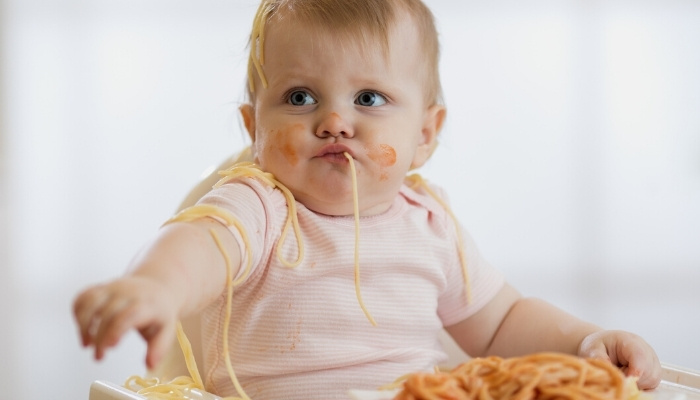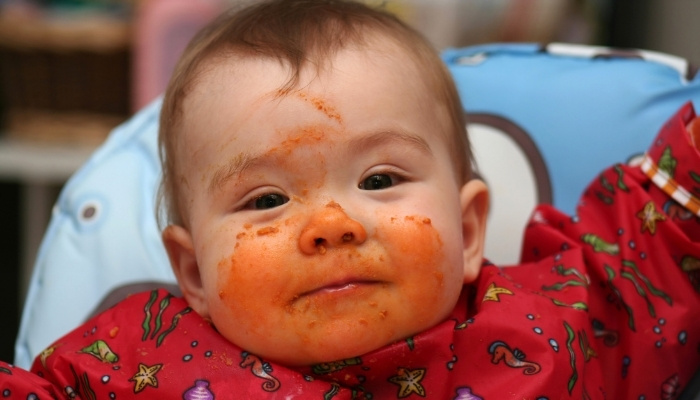How do you nourish your child’s developing mind and body? It can be overwhelming to sort through the overwhelming amount of advice available on raising children.
Your child is growing up, and you have questions. Straightforward answers about your baby’s milestones, development, and feeding are hard to come by. Let us make at least one aspect easy by taking a close look at baby-led weaning.
What is baby-led weaning? Baby-led weaning is a relatively new method of transitioning babies to solid food. With this approach, traditional baby food, purees, and spoon-feeding are largely skipped in favor of allowing the baby to explore foods independently. Many feel this method promotes healthier eating later in life.
All babies gradually wean off of breast milk or a formula-based diet to a solid food diet. Baby-led weaning emphasizes independence and allows parents to follow their baby’s lead. How does it work? Is it safe? Let’s explore baby-led weaning.
How Does Baby-Led Weaning Work?
Baby-led weaning is a unique approach to feeding. It changes the narrative for meal time, putting babies in charge. Baby-led weaning involves bypassing purees and spoon-feeding altogether and jumping straight to finger foods.
Babies lead meal time by feeding themselves, choosing which foods they like, and regulating how much food they eat. Baby-led weaning only works for babies who are at least 6 months old and capable of self-feeding.
Baby-Led Weaning vs. Traditional Weaning
Traditional and baby-led weaning are both types of complementary feeding in which solid foods are introduced parallel to ongoing breast milk or formula feeding. These weaning techniques start when a baby is around 6 months old.
Traditional weaning is when babies are gradually introduced to solids through spoon feeding and texture progression. The transition from breastmilk or a formula-based diet is a gradual process that allows the introduction of purees, thickened liquids, and different textures before moving to solid foods.
Baby-led weaning means skipping spoon-fed purees and allowing babies to feed themselves finger foods right from the start. This transition involves chopping and mincing foods that babies can explore, regulate, and enjoy at their own pace.
Baby-Led Weaning vs. Purees
| Baby-Led Weaning | Purees |
| Messy mealtimes | Cleaner mealtimes |
| Promotes motor skills development | Does not encourage the use of motor skills |
| Can save time and money | Can be time-consuming and expensive |
| Better acceptance of a variety of foods and textures | May increase the likelihood of picky eating |
| Encourages independence and self-regulation | Easier to know how much your baby is eating |
No matter the feeding method, the goal is to transition the baby to solid foods and to encourage a nutritious diet.
Can You Mix Purees and Baby-Led Weaning?
Yes, you can do both! Whether you are struggling to decide which method is right for your baby or just experimenting, mixing methods offers flexibility and opportunity.
By mixing methods, babies are allowed to explore, adapt, and experiment with feeding, creating healthier habits as they grow.
Is Baby-Led Weaning Healthy?
Baby-led weaning is healthy. It allows babies to learn how to chew more accurately and then swallow. It also prevents over-eating by allowing babies to control how much they are eating.
Baby-led weaning encourages motor skill development and allows children access to a more adventurous and nutritious diet.
Is Baby-Led Weaning Safe?
Baby-led weaning is safe when guidelines are followed.
Safety guidelines for baby-led weaning include:
- The child is 6 months or older.
- The child is being supervised.
- Baby-led weaning is used as a complimentary form of feeding alongside breastfeeding or formula.
- Foods are kept soft, minced, or chopped.
- A variety of foods in a variety of textures are offered.
- Choking hazards are avoided.
When Do Babies Self-Wean?
Babies who self-wean are usually over a year old. Self-weaning babies eventually get most of their nutrition from solid foods, use a cup regularly, and progressively cut down on nursing or formula feeding.
When children are allowed to fully self-wean, they are usually closer to the age of 2 years old before becoming fully weaned.
Baby-Led Weaning Pros and Cons
Baby-led weaning is a unique child-led approach to feeding. This approach is becoming heavily embraced and more common, but what are the pros and cons of this feed technique?
Advantages of Baby-Led Weaning
- Promotes independence
- Increased dexterity and motor skill development
- Encourages babies to try new foods, textures, and flavors
- Allows babies to learn how to chew and swallow more accurately
Disadvantages of Baby-Led Weaning
- Difficulty pinpointing allergic reactions
- Potential safety concerns or choking
- Hard to know how much your baby is eating
- Mealtimes are messy
Baby-Led Weaning American Academy of Pediatrics
The American Academy of Pediatrics recommends that your baby show signs of readiness before beginning solid foods.
Readiness signs include:
- Ability to hold head up in high chair or feeding seat with good head/neck control
- Interested and eager about food
- Ability to swallow thicker foods without spitting or gagging
- Weigh double their birth weight or at least 13 pounds

Baby-Led Weaning Age
The American Academy of Pediatrics recommends breastfeeding or formula as the sole source of nutrition for babies for at least the first six months.
Babies 6 months or older can begin complementary feeding methods while continuing to nurse or drink formula regularly.
Baby-Led Weaning 4 Months
It is not recommended that baby-led weaning is attempted before six months due to the risk of choking.
Baby-Led Weaning 6 Months
If your baby is meeting all safety and development requirements, 6 months is a great time to try baby-led weaning. At 6 months, babies should be eating one solid food meal a day. Foods should be cooked or soft enough to mash between fingers.
Can You Still Breastfeed With Baby-Led Weaning?
Baby-led weaning will complement breastfeeding, not replace it. Starting solid foods will fill nutritional gaps and encourage babies to explore tastes and textures.
Can You Do Baby-Led Weaning Without Teeth?
Teeth are not a requirement for baby-led weaning as long as your baby shows all signs of readiness.
Finger Foods for Baby With No Teeth
If the food is soft enough to mash with gums and diced small enough to avoid choking risks, there are numerous foods for your baby to eat with or without teeth.
Five finger foods for your baby without teeth are:
- Pasta
- Bananas/berries
- Avocados
- Roasted vegetables
- Eggs
When Can You Start Baby-Led Weaning?
You can start baby-led weaning when your baby is 6 months or older and can sit up with good head/neck control.
Signs Baby Is Ready To Wean
Your baby is ready to wean when they:
- Sit without support
- Coordinate their hands, eyes, and mouth
- Swallow food instead of spit it out
- Show an increased interest in food
How To Start Baby-Led Weaning
Start baby-led weaning by including your child at meal times. Introduce one food at a time, and offer them age-appropriate food in a highchair or feeding chair.
Introduce finger foods into their diet as early as possible. Ensure all foods are soft enough to avoid choking hazards.
First Foods for Baby-Led Weaning
First foods should be introduced one at a time to avoid allergic reactions. All foods must be soft enough to mush between fingers. The best practice is to ensure that foods are steamed or sliced so they can be chewed and swallowed easily.
Some of the best finger foods for 6-month-old babies are chunks of banana, avocado, or slices of fruit.
Baby-Led Weaning Book
Baby-led weaning books are used for numerous purposes. Some books provide recipes, schedules, or preparation suggestions, and others may be more informational in offering steps, tricks, and tips.
Baby-led weaning books are great tools for families considering this feeding method. I recommend the ones below for anyone interested in this feeding approach.
Simple & Safe Baby-Led Weaning
Simple & Safe Baby-Led Weaning by Malina Malkani MS, RDN, CDN is an all-inclusive book that supports parents from start to finish. Safety is a blanket theme throughout this book.
Simple & Safe Baby-Led Weaning not only teaches parents how to integrate new foods, but it also helps identify any allergies.
Baby-Led Weaning The Essential Guide
Baby-Led Weaning The Essential Guide, written by authors Gill Rapley, Ph.D. and Tracey Murkett, is a baby-led weaning survival guide! This book is an informative how-to treasure trove.
This guide gives families power over meal times, starting at the beginning as early as 6 months, supporting families throughout the preschool years.
Baby-Led Feeding
Baby-Led Feeding by Jenna Helwig gives parents easy-to-follow instructions for this complementary feeding method in addition to creative recipes. Each chapter includes photos along with safety and nutritional guidelines.
Final Thoughts
A baby’s development, health, and wellness are at the forefront of every parent’s mind night and day. Parenting is messy, and mealtime should be too!
Exploring complementary feeding methods or even mixing methods will help families find a balanced solution to their baby’s nutritional needs.
What works well for one child might not work for the next, but having options to experiment with is a gift. Happy eating!
Mom of three (including identical twin boys), wife, and owner of Parents Wonder. This is my place to share my journey as a mother and the helpful insights I learn along the way.

